Filipino Boxing
DAHMS ACADEMY OF MARTIAL ARTS
10 WEEKS OUTLINE - PANUNTUKAN
(LEVEL 1)
Basic three minute drilling then switch same task to the other student and drill another three minutes.
WEEK 1
(30 minute) Warm up - Calisthenics, Mandella Pattern and the first three of seven foot work drills.
Note:[In the air means as in shadow boxing or in front of mirrors watching the motions.]
Teach (in the air) with body form - (heel up leg, and hip turn on punch) Jab (left hand leads stance), spend three minutes
drilling the jab only.
Teach (in the air) with body form - (heel up leg, and hip turn on punch) the cross (left hand leads stance), spend three
minutes drilling the cross only.
Drill (in the air) the bob on opponents jab and (palm) catch opponents cross.
" " the duck on opponents jab and pat side of fist on opponents cross.
" " the bob, duck, shoulder roll on opponents jab (or cross) and catch, pat, or scoop on opponents cross.
" the forward shoulder roll on opponents jab and scoop (to the inside of opponents wrist) on opponents cross.
Focus mitt drills Punch at the dummy! Dummy holds one mitt against chest or side of body while other is in the position
for the type of punch he wants. Two mitts are held out in position only when two or three fast strikes are desired. This
allows regulation of speed used (the time between each strike) -today jab and cross only.
WEEK 2
(30 minute) Warm up - Calisthenics, Mandella Pattern review and teach the fourth and fifth of the seven foot work drills.
Review-Teach body form - (heel up leg, and hip turn on punch) Jab and cross (left hand leads stance), spend three minutes
drilling them.
Teach (in the air) body form - (heel up leg, and hip turn on punch) left hook (left hand leads stance), spend three minutes
drilling it.
Teach (in the air) body form - (heel up leg, and hip turn on punch) right hook (left hand leads stance), spend three minutes
drilling it.
Focus mitt drilling combination - jab, cross, left hook; combination - jab, cross, right hook.
Drill the bob on opponents jab and (palm) catch opponents cross and you fire jab cross. (use focus mitts).
Drill the duck on opponents jab and pat side of fist on opponents cross and you fire jab cross. (use focus mitts).
Drill the forward shoulder roll on opponents jab and scoop (to the inside of opponents wrist) on opponents cross and you fire
jab cross. (use focus mitts).
Drill opponent jab cross left hook -response - is duck, bob, or shoulder roll and pat, catch, or scoop the cross and cover -
elbow destruction to the hook. (elbow out slightly, turn body slightly) ( to biceps or forearm)
WEEK 3
(20 minute) Warm up - Calisthenics, Mandella Pattern review and teach the sixth and seventh foot work drills.
Review (in the air) - Teach body form - (heel up leg, and hip turn on punch) Jab, cross, left or right hooks (alternate),
(left hand leads stance), spend three minutes drilling them.
Teach (in the air) body form - (heel up, leg and hip turn on punch) left or right uppercut (alternate), (left hand leads
stance), spend three minutes drilling it.
Teach (in the air) the over hand,- (heel up, leg and hip turn on punch) in combinations only, left, low right and left or
right overhand; also in combination only,- right, low left and you left or right overhand (alternate), (left hand leads
stance), spend six minutes drilling it.
Teach (in the air) garbage jab, quick returning, no body behind it, meant to draw or cause a reaction prior to the real
assault.
Focus mitt drilling
Drill the weave. Bob on opponents jab or cross and weave on the second, then fire one low ( on the weave) and one high and
high hook.
Drill opponent jab cross left hook -response - is duck, bob, or shoulder roll and pat, catch, or scoop the cross and cover
(elbow out slightly, turn body slightly) and elbow destruction ( to biceps or forearm) to the hook.
Jab, low cross, opponent bends or turns head a little and you over hand; Jab, cross, left hook.; Jab, cross, right hook.;
Jab, cross, left uppercut; Jab, cross, left uppercut.
WEEK 4
(20 minute) Warm up - Calisthenics, Mandella Pattern review all seven foot work drills.
Focus mitt drilling
Teach body form - (heel up leg, and hip turn on punch) Jab, cross, left hook and right high horizontal elbow; then Jab,
cross, right hook and left high horizontal elbow; (alternate), (left hand leads stance), spend three minutes drilling them.
Review left or right uppercut (alternate), (left hand leads stance), spend three minutes drilling it.
Review the over hand,- (heel up, leg and hip turn on punch) in combinations, left, low right and left or right overhand;
also right, low left and left or right overhand (alternate), spend three minutes drilling it.
Review garbage jab, move around, stay hard to hit, teach Tayada footwork and back peddle and side step footwork and hit.
Draw a reaction and fire a combination. (Controlled combination - in air near or out of range of other student).
Show feints draw reaction and fire (controlled) combinations.
Weave on opponents jab or cross and bob on the second, and you fire a cross, jab, right hook. Work the opposite also (Jab,
cross, left hook).
Drill opponent jab cross left hook -response - is duck, bob, or shoulder roll and pat, catch, or scoop the cross and cover
(elbow out slightly, turn body slightly) and elbow destruction ( to biceps or forearm) to the hook.
Jab, low cross, opponent bends or turns head a little and over hand; Jab, cross, left hook.; Jab, cross, right hook.;
Jab, cross, left uppercut; Jab, cross, left uppercut; Jab, cross, horizontal elbow. (work the left and right elbows)
WEEK 5
(20 minute) Warm up - Calisthenics, Mandella Pattern review all seven foot work drills.
Teach (in the air) - Slip, jab, cross, uppercut; Slip, jab, cross, hook; Side step, right uppercut, left jab, cross;
Side step, cross, left hook; right uppercut. etc.
Focus mitt drilling
Teach low jabs, cross, and hooks.
Teach Jab, cross, low left hook and then high left hook. (same arm) Also the jab, cross, low and high right hook.
Teach Jab, cross, left horizontal elbow, and same with right elbow.
Teach Jab, cross, left horizontal elbow, right vertical upward elbow
Teach body form - (heel up leg, and hip turn on punch) Jab, cross, left hook and right high horizontal elbow; then Jab,
cross, right hook and left high horizontal elbow; (alternate), (left hand leads stance).
Teach body form - (heel up, leg and hip turn on punch) left or right uppercut (alternate), (left hand leads stance), spend
three minutes drilling it.
Teach the over hand,- (heel up, leg and hip turn on punch) in combinations only, left, low right and left or right overhand;
also in combination only,- right, low left and left or right overhand (alternate), (left hand leads stance), spend six
minutes drilling it.
Teach garbage jab, quick returning, no body behind it, meant to draw or cause a reaction prior to the real assault.
This is prior to but leading to (set up punch, feints and fire combinations)
Focus mitt drilling
Drill the weave. Bob on opponents jab or cross and weave on the second, then fire one low ( on the weave) and one high and
high hook.
Drill opponent jab cross left hook -response - is duck, bob, or shoulder roll and pat, catch, or scoop the cross and cover
(elbow out slightly, turn body slightly) and elbow destruction ( to biceps or forearm) to the hook.
Jab, low cross, opponent bends or turns head a little and over hand; Jab, cross, left hook.; Jab, cross, right hook.;
Jab, cross, left uppercut; Jab, cross, left uppercut.
Opponent feeds a combination of three, use the duck, bob, weave, or slip, and you fire a three combination.
WEEK 6
(20 minute) Warm up - Calisthenics, Mandella Pattern review all seven foot work drills.
Teach (in air) forearm and shoulder stop. Punch to inside of arm or shoulder as opponent tries to jab, cross, or uppercut.
Teach the cover! (Elbows like the needles of a porcupine hitting the pressure points). Wrists flat on forehead, (note wrist
almost always stay anchored on forehead or face), elbows point out slightly, always watching opponent even while striking,
look through center. Opponent feeds jabs or cross, backhands or hammer fist. Twist or turn body slightly to adjust so that
tip of your elbow runs into his fist for destruction. (target between knuckles or backhand) (no hitting back at all resist
the urge, rest, breath, study his movement, and let him try to beat on you.
Focus mitt drilling
Coaching. A Coach gives feed back and helps correct problems and create proper form and movements.
Now the dummy becomes the coach. Now using six beats of punching; he holds the mitts in positions to be hit and the coach
taps the body or face of the student were it is open during the punching. Also he will now swing in the middle or at the end
of a sequence at the student with the mitts. A high wide hook, student must duck or weave and continue to punch. A low hook,
student must cover using elbow and twist the body and continue punching. On a an uppercut student must cover using elbows to
destruct and protect. A jab or cross, student must bob, slip, shoulder roll, duck, or weave.
Low left jab, left high hook, right cross; Low left jab, left high hook, right uppercut;
Jab, low right cross, left uppercut; Jab, uppercut, overhand; Cross, uppercut, overhand;
Garbage jab opponent reacts with left side step or bob, so you right cross, right low hook and right high hook;
" " " " " step forward and jab so you shoulder roll and left high hook, left hook again,
cross.
WEEK 7
(20 minute) Warm up - Calisthenics, Mandella Pattern review all seven foot work drills.
Continue teach more of the cover! Allow allot of movement now, back peddling (Elbows like the needles of a porcupine hitting
the pressure points). Wrists flat on forehead, (note wrist almost always stay anchored on forehead or face), elbows point out
slightly, always watching opponent even while striking, look through center.
He can crowd the attacker and push him off. Allot of movement, back peddling, duck, bob, slip, and weaving to avoid.
On uppercuts allow wrist to slide down onto face a little, bend at waist a little allow elbow to poke into center of his
forearm, as it tries to drive upward and in.
On hooks adjust slide wrist and twist or turn body as needed, turn elbow out just enough to poke into biceps or forearm as
fist tries to drive into the side of you or (if low) your body.
On over hands - slide elbow up, arm almost flat on side of face, again point elbow into opponents fist or forearm.
Focus mitt drilling
Coaching. A Coach gives feed back and helps correct problems and create proper form and movements.
In a free flow lots of footwork, movement and student can crowd and push off or back off or coach can back off every three
to six beats. If coach backs off he'll set himself and then student must come right in to punch again.
Opponent feeds jab or cross, you slip to inside of strike elbow pointing in as you cross, uppercut, overhand.
" " jab or cross, you slip to inside of strike elbow pointing in as you right uppercut, left and right hook.
" " " " elbow pointing in as you right and left uppercut, overhand.
" " " " elbow pointing in as you right and left uppercut, overhand.
" " " " elbow pointing in as you right uppercut, left overhand, right uppercut.
" " " " (left) elbow pointing same arm straightens to hit shoulder (shoulder stop)
you cross, uppercut, right uppercut.
" " " " (left) elbow pointing same arm straightens to hit shoulder (shoulder stop)
you cross, uppercut, right hook.
WEEK 8
(20 minute) Warm up - Calisthenics, Mandella Pattern review all seven foot work drills.
Teach the shift.
Opponent jabs as you shift, (rear foot on toes drops heel and front foot rises onto toes) left uppercut strikes arm and
three count follow up to body
.
Review or continue the cover! He can crowd the attacker and push him off. Allot of movement, back peddling, duck, bob, slip,
and weaving to avoid.
Focus mitt drilling
Coaching. A Coach gives feed back and helps correct problems and create proper form and movements.
In a free flow lots of footwork, movement and student can crowd and push off or back off or coach can back off every three
to six beats. If coach backs off he'll set himself and then student must come right in to punch again.
Three to six beat combinations:
Response drills:
Response combinations: Opponent Jabs
WEEK 9
(20 minute) Warm up - Calisthenics, Mandella Pattern review all seven foot work drills.
Continue to drill cover! Add hit! Student covering has studied opponents movements and when he sees an opening he can now
punch after the second or third hits to him!
Coaching. A Coach gives feed back and helps correct problems and create proper form and movements.
In a free flow lots of footwork, movement and student can crowd and push off or back off or coach can back off every three
to six beats. If coach backs off he'll set himself and then student must come right in to punch again.
Attacking the limbs
Opponent jabs as you side step (zone to outside of arm) and left punch to the attacking arm as it lowers, right punch it,
left uppercut to body, right then left hook.
Anytime student sees hands or arms out in striking range punch or elbow it and backfist or punch to face on that side of
opponents body. Example: opponents lead left arm close to chest right punch to forearm and left to face, and follow up.
Focus mitt drilling
Three to six beat combinations:
Response combinations:
Unmatched lead combinations:
Limited sparring with gear: (Three levels - slow speed, faster with limited contact, full but light contact full speed).
The high level student maintains the inner circle and can not step out of it in an attack. The lesser student on the outer
circle can attack and enter the inner and go back out as he needs to avoid. Second student learn to attack with at least
three beat combinations. When it gets to fast and strong, he can back out without the opponent being able to follow with his
attacks. The second student can then circle and move as he wishes, reenter and attack. This allows him to develop his
combinations and attack strategy with out to much pressure while still feeling the contact.
WEEK 10
(20 minute) Warm up - Calisthenics, Mandella Pattern review all seven foot work drills.
Coaching. A Coach gives feed back and helps correct problems and create proper form and movements.
In a free flow lots of footwork, movement and student can crowd and push off or back off or coach can back off every three
to six beats. If coach backs off he'll set himself and then student must come right in to punch again.
Focus mitt drilling
Three to six beat combinations:
Response combinations:
Unmatched lead combinations:
Attacking the limbs
These destruction drills are on the verge of Pangamut. If trapping techniques were introduced it would begin it!
Opponent jabs you right horizontal elbow (pull in front of your face as he punches at it) to the attacking arm as it lowers
right backfists it, as left down elbows arm, left backfist to face as right crosses, left hooks high, right uppercut, right
high hook.
Limited sparring with gear: (Three levels - slow speed, faster with limited contact, full but light contact full speed).
The high level student maintains the inner circle and can not step out of it in an attack. The lesser student on the outer
circle can attack and enter the inner and go back out as he needs to avoid. Second student learn to attack with at least
three beat combinations. When it gets to fast and strong, he can back out without the opponent being able to follow with his
attacks. The second student can then circle and move as he wishes, reenter and attack. This allows him to develop his
combinations and attack strategy with out to much pressure while still feeling the contact.
Sparring with gear. (Allowed only by permission and with Black Belt supervision)
|



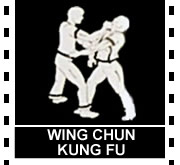
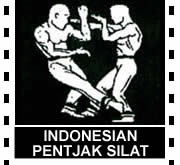


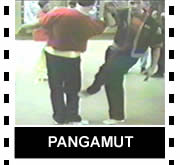

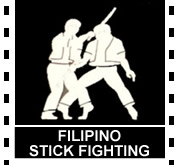




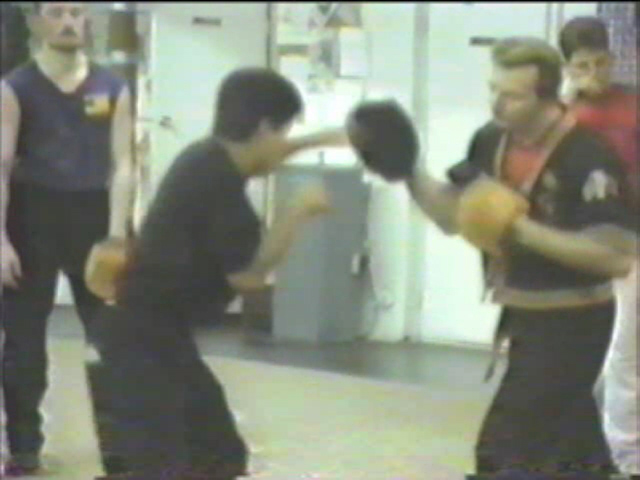 Datu Drilling students Panantukan combinations using Focus Mitts
Datu Drilling students Panantukan combinations using Focus Mitts Datu demonstrating counters from hit & cover position use of elbows in Panantukan
Datu demonstrating counters from hit & cover position use of elbows in Panantukan Propper Punching Form & Range demonstrated by Gracealis Cassillas JKD Inst. under Dan I
Propper Punching Form & Range demonstrated by Gracealis Cassillas JKD Inst. under Dan I